(This is the seventh and final article in our new Agri-Pulse series, “The Seven Things You Should Know Before You Write the Next Farm Bill.” Each segment provides important background and “lessons learned” that can help inform and stimulate debate before formal work starts on writing the next farm bill.)
WASHINGTON, March 26, 2017 – When President Abraham Lincoln signed the Morrill Act into law in 1862, he set in motion the development of a system of land grant colleges and helped create the foundation for U.S. agricultural research that’s endured until today.
That foundation is still strong, thanks to formula funding established by Congress over the years, but there are new fears that the U.S. is no longer leading way in innovation.
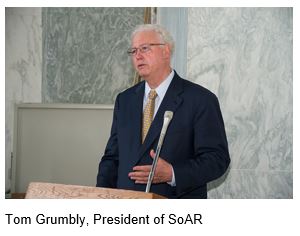 Part of the answer is money, says Tom Grumbly, president of the Supporters of Agriculture Research (SoAR) Foundation. But perhaps an even bigger piece of the equation is finding the right policy and management system to govern the complex web of government-funded research programs. SoAR and its supporters are pushing for an overhaul in the next farm bill. They want a power shift at USDA to elevate the department’s top scientist to a near-cabinet level position.
Part of the answer is money, says Tom Grumbly, president of the Supporters of Agriculture Research (SoAR) Foundation. But perhaps an even bigger piece of the equation is finding the right policy and management system to govern the complex web of government-funded research programs. SoAR and its supporters are pushing for an overhaul in the next farm bill. They want a power shift at USDA to elevate the department’s top scientist to a near-cabinet level position.
It’s a big request, but not unprecedented as leaders throughout U.S. history have tried to change policy and management to get past immediate short-term issues and focus on the long game of science.
“You cannot escape the responsibility of tomorrow by evading it today,” Lincoln said, way back when, and while he may have been talking about abolishing slavery, he could just as easily have been describing the need for America to invest in agricultural research.
Fast forward 150 years and current House Agriculture Committee Chairman Mike Conaway expressed a similar sentiment in an interview with Agri-Pulse.
“Ag research is vitally important for the long term,” Conaway said. “We have immediate issues and then we have long-term issues. It’s going to take the wisdom of Solomon to parcel out whatever resources we get across that array of priorities. Scientific research in the ag industry is vitally important … For my money, scientific research in ag repays the money invested over the long haul.”
Conaway will be helping write the next farm bill, but he won’t be doing it alone, and the priority of Congress has always focused first and foremost on the safety net programs for America’s farmers in Title I – not intangible promises of future cures and breakthroughs in Title VII, which deals with research.
But the future is closer than it seems as new plant and animal diseases present bigger and bigger threats, and that’s pushing researchers harder than ever to get a single message to Congress in the lead-up to the 2018 farm bill: Better science and innovative policies are needed if farmers are going to be able to continue to feed the world.
It’s not a new message, but it’s becoming more urgent as the amount of arable land remains constant or shrinks and the world’s population continues to grow.
 Ironically, government funding for agriculture research continued to slide downward over the past 40 years as demand increased for farmers to produce more while using sustainable methods. In the early 1970s, about 6 and a half percent of federal research dollars went to agriculture science, according to Grumbly. That level is now down to just 3 percent.
Ironically, government funding for agriculture research continued to slide downward over the past 40 years as demand increased for farmers to produce more while using sustainable methods. In the early 1970s, about 6 and a half percent of federal research dollars went to agriculture science, according to Grumbly. That level is now down to just 3 percent.
It’s the primary reason behind SoAR’s latest all-out effort to get Congress to act. The group wants more money for researchers – a lot more money – but perhaps more importantly, it is advocating for a shakeup at USDA and a new structure for the way that federal programs are run.
This was the same message that lawmakers were getting from the research community more than a decade ago as the process to create the 2008 farm bill was in full swing. Demands for a new way of managing research were escalating and thousands of individual requests for increased research funding were pouring into the Senate and House Agriculture committees.
AFRI is born, providing new hope for the future
Sitting in his Longworth Building office on Capitol Hill, House staffer John Goldberg was feeling the pressure. Just a couple years earlier, in 2004, the USDA Research, Education and Economics Task Force, under the guidance of the esteemed plant biologist and medical doctor William Danforth, had submitted to Congress its report supporting the creation of the National Institute of Food and Agriculture (NIFA).
The primary objective behind NIFA – essentially a restructuring of the Cooperative State, Research, Education and Extension Service (CSREES) – was to ensure “the technological superiority of American agriculture.” NIFA was a good and essential part of what scientists like Danforth believed to be the response to “an impending crisis in the food, agricultural, and natural resource systems of the United States.”
But Goldberg said he was certain more was needed. On the one hand, he had the NIFA report, on the other hand he had two competitive-grant programs that were very similar but also in conflict with each other.
“When you’re going through the process, constituents are coming through and asking for very targeted, individual research authorizations,” Goldberg recalled. “To the extent that anybody went beyond just the parochial interests, it was usually just simply asking for more money.”
There was a constituency that favored the grants in the Initiative for Future Agriculture and Food Systems (IFAFS) and there were those who favored grants in the National Research Initiative (NRI), but Goldberg said the distinction were minor, and he came up with the idea to combine the two.
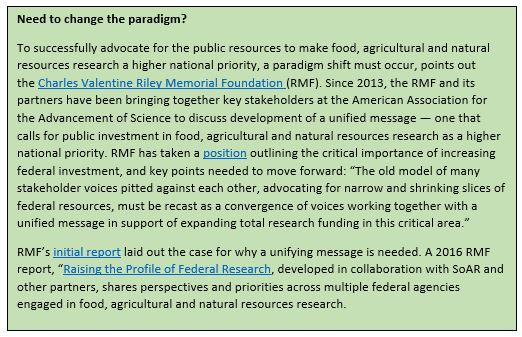 He went to his boss at the time – Rep. Bob Goodlatte – and pitched the idea for the Agriculture and Food Research Initiative, now well-known by the acronym AFRI. Goodlatte, a Virginia Republican, said he liked it and told Goldberg to run with it.
He went to his boss at the time – Rep. Bob Goodlatte – and pitched the idea for the Agriculture and Food Research Initiative, now well-known by the acronym AFRI. Goodlatte, a Virginia Republican, said he liked it and told Goldberg to run with it.
“When we had the individual programs, we were thinning the resources, trying to push for funding,” Goldberg said, explaining one rationale behind the combination.
The idea was initially a hit with other House and Senate staffers and gained enthusiastic support from the likes of Sen. Tom Harkin and Rep. Collin Peterson. So AFRI was created, tucked into NIFA and Title VII of the Food, Conservation, and Energy Act of 2008.
And AFRI has been the star jewel of ag research ever since.
Just last year, Zippy Duvall, president of the American Farm Bureau Federation, hailed the grant program as America’s best chance to combat avian influenza, the virus that forced farmers to destroy 48 million chickens and turkeys in 2015.
“We need a more effective and modern way of ending these outbreaks,” Duvall said in an op-ed published by The Hill last April. “Scientists at Ohio State and the University of Cincinnati are answering this challenge by analyzing the flu virus and how it jumps from poultry to people to pigs. This collaboration, funded by the NIFA’s Agriculture and Food Research Initiative (AFRI), is one of many exploring new ways to better identify and control future outbreaks.”
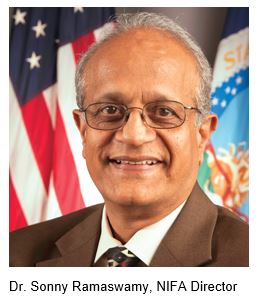 NIFA director Sonny Ramaswamy sat down with Agri-Pulse to talk about the program – its successes as well as shortcomings that have stood in the way of allowing it to shine even brighter.
NIFA director Sonny Ramaswamy sat down with Agri-Pulse to talk about the program – its successes as well as shortcomings that have stood in the way of allowing it to shine even brighter.
“The vision articulated in creating NIFA and AFRI was not to use small amounts of money for evolutionary increases in knowledge, but truly revolutionary, transformative increases in knowledge,” said Ramaswamy.
AFRI, he said, has been drawing on the excitement to innovate from the private sector, the academic sector and the government sector, he said, and the results have often been astonishing.
For example, when an Alaska Airlines Boeing 737 touched down at Reagan National Airport in Washington, D.C., on Nov. 14, 2016, then-USDA Secretary Tom Vilsack was proudly waiting for it. That’s because the jet fuel used to power the cross-country trip from Seattle, had been partially made from wood chips, and the science used to make that happen had been partially funded by a $40 million AFRI grant.
“In 2011, USDA awarded our largest-ever competitive research grant to the Northwest Advanced Renewables Alliance, betting on the promise that cellulose-rich, discarded wood products could be a viable renewable fuel source instead of going to waste,” Vilsack said in a statement released after the plane landed. “Today, we are able to celebrate the results of that investment, which is a major advancement for clean alternatives to conventional fossil fuels.”
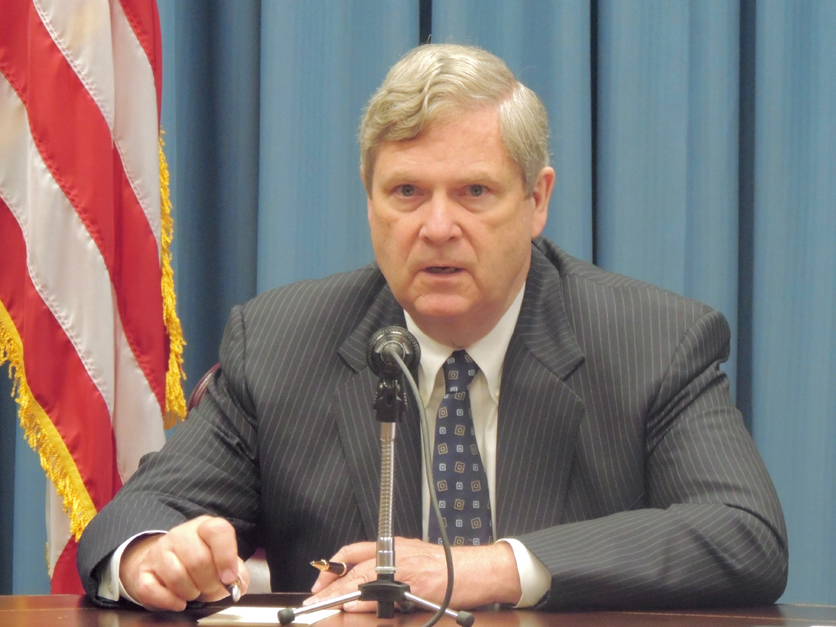 The House version of the 2008 farm bill tried to protect $200 million in mandatory funding for AFRI, but it didn’t survive the conference committee. Still, AFRI has managed to prosper. Funding for the combined competitive grant program – the program that the research sector hoped would help propel agricultural research the way that medical research blossomed at the National Institutes of Health (NIH) – has gotten incremental increases over the years, rising from an initial $190 million to its current level of about $350 million.
The House version of the 2008 farm bill tried to protect $200 million in mandatory funding for AFRI, but it didn’t survive the conference committee. Still, AFRI has managed to prosper. Funding for the combined competitive grant program – the program that the research sector hoped would help propel agricultural research the way that medical research blossomed at the National Institutes of Health (NIH) – has gotten incremental increases over the years, rising from an initial $190 million to its current level of about $350 million.
It’s a substantial increase, so long as you don’t compare it to the meteoric rise of research under NIH. In the mid-1970s, the government spent about $1 billion on both agriculture and medical research, Ramaswamy says. Today the NIH gets about $30 billion per year and more than 80 percent of it goes to pay the salaries of more than 300,000 scientists at about 2,500 universities and other institutions across the country.
In 1970s, SoAR’s Grumbly said, $1 out of every $16 of total federal research money went to agriculture science. Today that ratio is about $1 out of every $30.
Pharmaceutical companies banded together in the 1980’s to form Research America, a group that better enabled them to lobby successfully for massive increases in spending on medical research.
While SoAR – effectively the agricultural version of Research America – is lobbying hard and in the midst of yet another campaign to drum up support, medical science may always have the edge on Capitol Hill and with the public. That’s perhaps the fault of our farmers and ranchers for keeping the country so well-fed -whereas most people have been impacted by cancer or other diseases that we all wish there was a cure for, not many know someone who has starved to death.
 Barbara Glenn, CEO of the National Association of State Departments of Agriculture (NASDA), says there’s no reason ag research shouldn’t share the spotlight.
Barbara Glenn, CEO of the National Association of State Departments of Agriculture (NASDA), says there’s no reason ag research shouldn’t share the spotlight.
“Everyone that has had a sick relative sees benefits of biomedical research, it’s a very personal thing,” she told Agri-Pulse. “I would argue our food is very personal, too. Our friends and neighbors need to understand that it’s just as important to invest in food and ag as it is to invest in biomedical research.”
Much of the success of medical research is also attributed to the competitive nature of the NIH grants, and that’s why Grumbly and others are pinning the hopes of farm research expansion on AFRI – the main competitive branch of research at NIFA – but SoAR and the science community aren’t leaving out the formula-funded land grant university system and in-house science by the Agricultural Research Service. Indeed, beyond just the formula-funds, scientists at the nation’s land grant universities have been pulling in about 80 percent of the competitive grants, and that’s not expected to change.
It’s not just AFRI that was the source of new competitive grant funding. Lawmakers also created the Specialty Crop Research Initiative (SCRI) in the 2008 farm bill after prolific lobbying on behalf of fruit, vegetable, tree nut and horticulture producers.
It was in January of 2007 when USDA Secretary Mike Johanns presented Congress with a proposal for the 2008 farm bill (At the time it was still expected to be the 2007 farm bill), and specialty crops were highlighted like they had never had been before.
For two years the USDA had been holding farm bill forums across the country. After 52 of them, Johanns said that the message was clear: More specialty crop research was needed.
One of the results was that the USDA proposed $1 billion over 10 years for the SCRI, the first-ever national competitive grant program specifically for fruits, vegetables and other specialty crops.
But it wasn’t just the USDA that was listening to groups like the United Fresh Produce Association. They were getting a warm reception on Capitol Hill and finding champions like Sen. Debbie Stabenow.
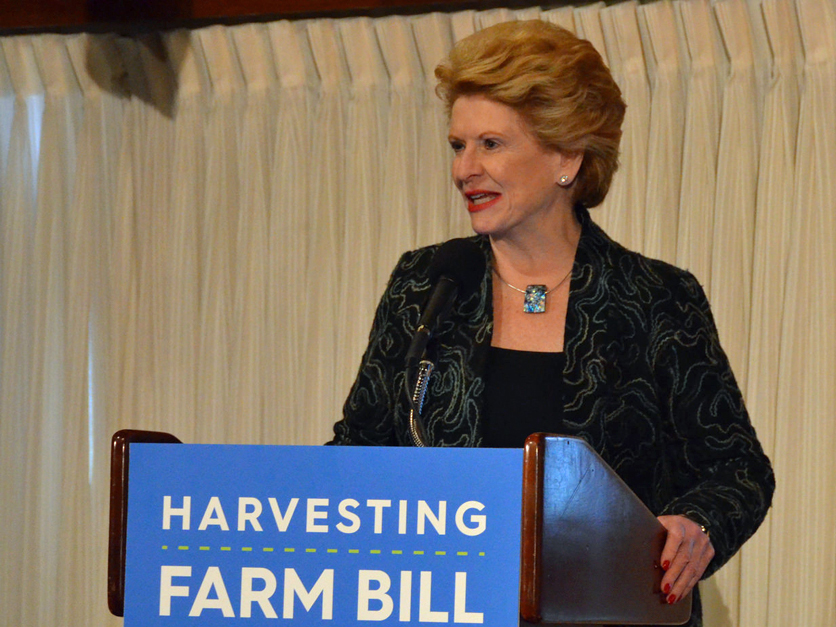 Not only did she say she’d support SCRI, but said she wanted an entire specialty crop title for the farm bill, one lobbyist recalls from a pre-farm bill meeting with the Michigan Democrat.
Not only did she say she’d support SCRI, but said she wanted an entire specialty crop title for the farm bill, one lobbyist recalls from a pre-farm bill meeting with the Michigan Democrat.
As a result, SCRI ended up getting $230 million in mandatory spending for the life of the 2008 farm bill. It wasn’t as much as the Johnanns proposal, but more than either the Senate of the House proposed in their respective bills.
Lawmakers doubled down on the program in the 2014 farm bill, giving SCRI $80 million per year through 2018.
Competing with Title I (If you can’t beat them, join them)
When it comes to the farm bill, there’s just no competing with the safety net programs in Title I. And when it comes to getting the attention of farm state lawmakers, there’s no better people to do that then the heads of some of the largest farm groups in the country that represent America’s farmers and ranchers.
“Some of the people in the commodity community are getting it,” Grumbly said. “It’s because the leadership in those organizations are beginning to realize that they’re not going to be able to continue to make the kind of innovations that are needed to drive down production costs in an environmentally-sensitive way.”
In May of last year SoAR, announced several new board members including Neil Dierks, CEO of the National Pork Producers Council; Chris Novak, CEO of the National Corn Growers Association; Richard Wilkins, then- president of the American Soybean Association and Farm Bureau member; and Erik Olson, senior strategic director for the Natural Resources Defense Council.
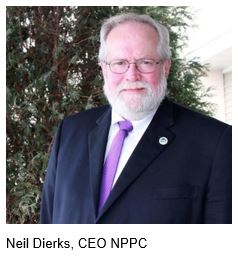 And it was just four months later that Duvall – leader of the largest and most influential farming group in the country – penned his op-ed that got immediate cheers from the research sector.
And it was just four months later that Duvall – leader of the largest and most influential farming group in the country – penned his op-ed that got immediate cheers from the research sector.
“Whether our challenge of the day stems from a new government edict that affects how we farm, another nation’s decision to ban our products, or an unforeseen disease outbreak, there is really only one solution on which we hang our collective hat – cold, hard science,” Duvall wrote. “Research has helped us increase yields, decrease inputs, and ward off plant and animal diseases. Research has made us more productive on fewer acres and has decreased our environmental footprint.”
It's statements like this that Grumbly points to when he talks about farmers’ evolving priorities and the elevation of science on their priority lists.
Farmers and farm groups continue to say “that Title I programs in the farm bill are still the most important thing to us,” Grumbly conceded. “I understand that. But they’re beginning to say that science and research are part of their priority lists – not way down, but up a lot.”
Farmers may need science more than they know, but as the farm bill debate begins to rage and lawmakers are putting together the pieces of the 2018 legislation – not to mention the 2018 appropriations bill, scientists also need the farmers.
It’s why Grumbly and his team at SoAR have been reaching out to the farm groups to get new allies.
“I think that’s critical because I don’t think that the appropriations committees of Congress or the authorizing committees for the farm bill will respond positively if it’s only what seems to be the self-interest of the scientific community, urging them for more money,” Grumbly explained. “It has to be the people whose lives actually depend on the results of research to make that case.
“We’re bringing together a coalition that includes a significant number of organizations that are traditional commodity organizations. And we think only by doing that will we be able to create the support that members of Congress will (need) to be able to look in the mirror … and say. ‘I’m going to support that.’”
Randy Russell, president of the influential lobbying firm The Russell Group, said that the efforts are already working.
 “You look at the previous farm bills and research has been at the top of the ‘B’ list for a lot of organizations,” Russell said in an interview. “I think that’s starting to change. When you go up and talk to the chair and the ranking members (of the Senate and House Agriculture Committees), research is now a much higher priority for them.”
“You look at the previous farm bills and research has been at the top of the ‘B’ list for a lot of organizations,” Russell said in an interview. “I think that’s starting to change. When you go up and talk to the chair and the ranking members (of the Senate and House Agriculture Committees), research is now a much higher priority for them.”
Part of Russell’s job is meeting with senators, representatives and their staff, but he also spends time with the farm groups and he says he’s seeing a real shift in priority there too.
“There is really a renewed interest in ag research – making it a priority in the upcoming farm bill,” he said.
One of those farm groups that is making research a priority is the National Pork Producers Council.
About a month ago, NPPC CEO Neil Dierks gathered the group’s farm bill task force from around the country to meet in Washington.
Dierks and the 17 representatives from the pork industry sat around a table in the group’s headquarters, just a few blocks from Capitol Hill. The visiting farmers, meatpackers and other members settled on just two requests for Congress in the 2018 farm bill: The establishment of a foot and mouth disease vaccine bank and increased funding for agriculture research.
The NPPC board of directors approved both.
Dierks stressed, though, that it is research for all of agriculture that NPPC supports and not just studies that support swine production. Pork researchers, he said, will compete along with everyone else.
“It benefits everybody,” he added. “It’s a greater good for society.”
But there’s a lot that researchers are asking Congress to support. Just as Congress agreed to a structural overhaul and created NIFA and AFRI in the 2008 farm bill, SoAR and its coalition are asking for big changes again.
They want new policy that will add mandatory funding for AFRI – something that’s never been done – and they want a stronger and more independent NIFA director.
Russell explained that rather than a USDA Under Secretary for Research, Education, and Economics (REE) that encompasses the entire mission area, what’s called for is a powerful director who is also the chief scientist and has only two core responsibilities: the intramural research that’s conducted by in-house scientists and extramural research conducted under competitive grants.
“I think we need to change the culture, change the management and then the funding will follow,” Russell said.
Lawmakers authorized AFRI at $700 million when the program was created in 2008, but it’s never gotten the budget to match. Today it stands at about just half that, but Grumbly and others are confident they’ll get there soon and SoAR has structured its funding proposal on that bet.
The proposal stipulates that the first $700 million in AFRI’s yearly spending would still come from discretionary funds, but reaching that target would trigger the ability to use mandatory funds.
The proposal, Grumbly said, would eventually add about $1 billion to the overall research budget at USDA.
Another leader in the science community that’s going to be fighting to thrive in the 2018 farm bill is Sally Rockey, the executive director for the Foundation for Food and Agriculture Research (FFAR).
FFAR is another attempt by lawmakers to energize agricultural science and Rockey – who works out of a nondescript building near D.C.’s Chinatown with a meager staff of 12 – said the Foundation is doing exactly that.
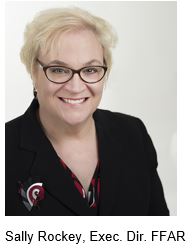 The Foundation matches government funds to private investment for research that might otherwise go unfunded in more common competitive or land grant research programs.
The Foundation matches government funds to private investment for research that might otherwise go unfunded in more common competitive or land grant research programs.
Created in the 2014 farm bill and championed by Democratic Sens. Debbie Stabenow and Amy Klobuchar and Republican Sen. Pat Roberts, the Foundation may have gotten off to a slow start, but that’s changing this year.
In fact, the foundation recently announce its first major collaboration on a grant to sponsor a study into improving the nation’s soil health. FFAR, together with the Samuel Roberts Noble Foundation, will be funding a $6.6 million study on cover crops in five states.
But that’s just the beginning. FFAR, together with agricultural businesses, universities and other foundations, plans to fund at least $62 million worth of projects, according to a FFAR spokeswoman. Last year – the second of the Foundation’s existence – it handed out a total of $4.8 million to nine university researchers.
“We’re really hitting our stride now,” said Rockey, who has previously worked for both USDA and the National Institutes of Health.
Altogether, though, that’s a major chunk of the Foundation’s finite funds. It was given $200 million in mandatory funds by Congress, but when that runs out it doesn’t replenish.
Rockey said she hasn’t begun focusing on making the case to reauthorize FFAR in the next farm bill, but stresses it shouldn’t be too hard of a sell.
“We have a great relationship with Congress,” she said. “We keep in constant contact with (lawmakers) because they’re very interested in our success.”
Scientists show AFRI is worth its weight in grant funding
SoAR, meanwhile, is asking for a lot of money, but scientists around the country have already shown that they are producing significant results from what little is already available.
It’s not just research that allows woodchips to fuel airplanes that is being made possible by AFRI. Ohio State scientists are using funds from the program to improve the immune systems of chickens and help fight off avian influenza.
“When an outbreak occurs, there is support from everywhere for new research,” said Chang-Won Lee, an Ohio State researcher. “However, the work needs to be done on an ongoing basis in preparation for the next outbreak.”
At North Carolina Agricultural and Technical University scientists used AFRI funds to help remove 98 percent of the allergens in peanuts. The school has patented the process and licensed it to companies that are working on getting the peanuts onto the market.
Recombinetics Inc., based in St. Paul, Minnesota, used $435,000 of AFRI grant money to breed cattle without horns through gene editing. De-horning cattle is must for the dairy industry in order to prevent the animals from injuring each other, but the process is time consuming, expensive and, for the cattle, unpleasant.
Researchers have bred cattle conventionally without horns in the past, but a side effect was they produced lower-quality milk. The gene-edited cattle don’t have that problem.
And at Texas A&M University, AFRI funds went into studying the genomes of thousands of beef and dairy cattle from New Mexico, Colorado, California, Washington and Texas. Researchers were looking for genetic variants associated with the susceptibility to bovine respiratory disease. Christopher Seabury, one of the project scientists, said they were successful.
Using their results, Seabury predicted that ranches and dairies will be able to significantly keep the disease out of future herds, saving the industry billions of dollars.
But he also stressed that the funding is just not there for many scientists with projects just as valuable as his.
Seabury, who spoke at a recent briefing for Capitol Hill staffers, said he serves on five separate panels that choose grant recipients from the hundreds of proposals that are submitted.
Under a typical panel, he said, there may be up to 250 applicants that have to be judged. Of those 250, there are usually 25 to 45 proposals that are deemed “outstanding” and given high priority. But only between eight and 12 are actually funded, Seabury said.
“We’re actually rate-limiting ourselves in terms of the amount of agricultural progress and food security that we could have in the United States in terms of sustainable agriculture by not investing in our future,” he told the Hill staffers.
NIFA’s Ramaswamy gave Agri-Pulse a higher estimate of grant approvals – he said an average of one in 10 is approved – but still called it an “incredibly tough” rate.
Grumbly went further: “AFRI has left over $3 billion worth of research that was rated as excellent on the table in the last three years,” he said. “That’s unconscionable in this day and age and represents a huge opportunity cost for our society.”
Gary Felton, head of the Entomology Department at Penn State University and another of the visiting scientists who took part in the Hill briefing, called it a sad situation.
“The quality of the applications in the U.S. is still very high, but we just haven’t had the dollars to fund the research,” Felton said in a report distributed to staffers. “In many cases, we don’t know what we are missing.”
The problem is so bad, Seabury said, that foreign governments are trying to poach our scientists and their research.
What’s researched in China stays in China
It was just a couple of weeks ago at a meeting held by the American Association for the Advancement of Science that Felton noticed something he’d never seen before at one of these gatherings.
Scientists were carrying their papers and other documents in bags with a European Union logo on them. Not only that, but EU representatives were handing out pamphlets, inviting U.S. scientists to take their work across the Atlantic Ocean.
Felton said he doesn’t normally take the freebie bags at these kind of events, but he took this one and saved it. One side of the bag reads: “Open to the World, Destination Europe.”
But it’s not just the EU that’s ramping up investment in agricultural research so much that they are willing to pay for U.S. science. It’s also China, India, Brazil and Australia.
John McDowell, a Virginia Tech scientist who is researching new ways to protect soybeans from destructive pathogens, explained his frustration this way: “When I look at my counterparts in China, what I see is they have resources … that are greater than mine on the order of two-to-fivefold, and I’m relatively well-funded. Their resources are on a whole other level.”
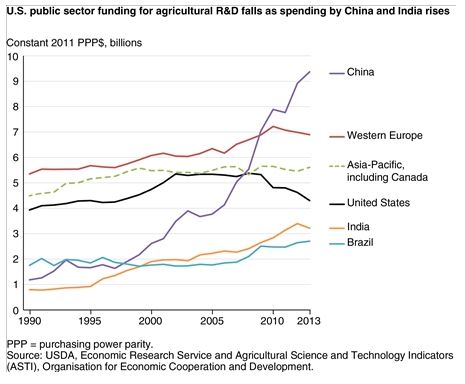 The investments those countries and others are making have already begun to show results, said Russell.
The investments those countries and others are making have already begun to show results, said Russell.
“If you look at our productivity increases going back to the early 70s, we’ve averaged about 1.5 percent productivity increase year after year,” he said. “Meanwhile (during) the last probably two decades China and Brazil are increasing their productivity on an annual basis somewhere in the neighborhood of over 2 percent. They’re investing billions in ag research and we need to take a hard look at that from our own competitiveness perspective as we move forward.”
If the results of all of that research that China is funding were made available to the world, that might be acceptable. But with China, that’s often not the case, scientists say.
“Some people will say that science is science and it doesn’t matter where it’s going to – it’s an international enterprise,” Grumbly said to the audience of Hill staffers. “That’s not true when it comes to China.”
A ‘cereal killer’ that only science can profile
If the thought of losing research superiority to China isn’t enough to get lawmakers behind agriculture research, the scientific community has another card up its sleeve: the threat of impending disaster for major crops.
U.S. farmers grow about 2 billion bushels of wheat every year to make the bread, pizza dough, donuts, pretzels, cookies and noodles that we eat. And it’s all at risk from a devastating fungus that’s making its way around the world and wreaking havoc in the fields it touches.
Just one spore of the Triticum pathotype of the fungus Magnaporthe oryzae – known more commonly as wheat blast – is enough to kill a wheat head. A severe infection can wipe out a farmer’s entire crop. That’s the scene that replayed over and over in Bangladesh last year.
The closely related rice blast has been around for about 7,000 years and farmers are equipped to deal with it, according to Barbara Valent, a Kansas State University researcher and the preeminent expert on the fungus in the U.S. But wheat blast was first detected only about 20 years ago in South America and farmers still have no real defenses.
It’s still not completely clear how the fungus got to Bangladesh, but Valent said it can travel through the seed and grain trade. And that’s scary, she warned.
The fungus that caused between 30 percent and 100 percent losses throughout southern Bangladesh last year has not reached the U.S. yet, but Valent fears it’s only a matter of time.
Researchers at Kansas State, the University of Arkansas, the University of Kentucky, Ohio State, Purdue University, and USDA’s own Agricultural Research Service have received about $5.4 million in AFRI funds since 2009 to fight both wheat and rice blast, according to NIFA.
Scientists have used that money to come up with the first wheat gene that’s resistant to the blast fungus, but that’s not nearly enough, Valent said. There are hundreds of resistant genes for rice blast and now there’s only one for wheat – and that one’s not very effective.
Meanwhile, Valent is leading the effort to try to detect what she calls a “cereal killer” that’s on the move again and has likely already spread to crops in India this year.
Detection is key she said, because the fungus could arrive in U.S. fields and begin spreading long before farmers know it’s there. It’s complex work she said, but it’s not just time that’s running out – it’s money, too.
Like what you see here? Agri-Pulse subscribers get our Daily Harvest email and Daybreak audio Monday through Friday mornings, a 16-page newsletter on Wednesdays, and access to premium content on our ag and rural policy website. Sign up for your four-week free trial Agri-Pulse subscription.
“This research was supported by two competitive grants,” she said. One of them has finished and “one of them runs through the end of the year and then there’s no more funding.”
There’s also a threat to the U.S. orange juice industry. Unlike wheat blast, the tree-killing Huanglongbing disease, or citrus greening, has ravaged Florida orange groves for years and is quickly bringing the industry to its knees.
USDA is now predicting that Florida will produce just 71 million boxes of oranges this year, That’s a 13 percent decline from just last year and less than half of the 162 million boxes produced in 2009, before citrus greening took hold in the state’s groves, according to Candice Erick, head of the Florida Department of Agriculture and Consumer Services. The statistics are a morbid testament to how fast the disease spreads on the wings of the Asian citrus psyllid.
The Agriculture Department has spent about $400 million since 2009 on research to combat the disease, which causes fruit to shrivel and become unsellable as well as eventually killing the trees. In January, NIFA announced $13.6 million in new SCRI competitive grants to try to save Florida’s groves.
Perhaps one of the most promising efforts is a Clemson University research project led by Feng Luo. NIFA is giving him and his team $4.3 million this year to start a five-year study to create new lines of breeding that are resistant to citrus greening.
Luo is sampling citrus trees across the state of Florida, hunting for “mutants” that can naturally survive the deadly bacteria. Once he has enough mutants, he’ll be able to compare them to the more normal, susceptible trees and isolate the genetic targets that the bacteria latch onto.
Once those targets are established, Luo said, it should be easy to just remove them using the gene editing technique called CRISPR/Cas 9.
Science still faces uphill battle for new money and farm bill victory
What won’t be easy is getting Congress to increase funding for AFRI and make the authorizing changes for the program that groups such as SoAR are after.
Putting aside all of the evidence that scientific gains are essential to feeding the U.S. and the rest of the world, it just doesn’t seem that urgent to many when compared to tanking commodity prices, rising farm debt, sinking profit margins and endangered international trade pacts.
 The House Agriculture subcommittee on research, chaired by Illinois Republican Rodney Davis, recently held its first farm bill hearing and only four reporters showed. Most of the audience chairs were filled in the hearing room, but several members of the panel didn’t show up to listen to testimony and ask questions.
The House Agriculture subcommittee on research, chaired by Illinois Republican Rodney Davis, recently held its first farm bill hearing and only four reporters showed. Most of the audience chairs were filled in the hearing room, but several members of the panel didn’t show up to listen to testimony and ask questions.
The research community can make its case, but it can’t make lawmakers listen.
“This is one of those things that’s important, but every time around it isn’t like it’s the urgent thing,” NPPC’s Dierks said. “But it is important and we just can’t let it go by the wayside … Sometimes the greater good for society loses out to more specific items, but we’ve gone a long time with flat funding for ag research. At some juncture, we have to change that equation.”
It’s unclear, though, if Congress is at that juncture yet.
The same day of Davis’ subcommittee hearing, President Donald Trump released his “America First” budget proposal for fiscal year 2018. Not a lot of details were included in the “blueprint” document, but it did include a line promising to keep AFRI stable at $350 million, still just half of the 2014 farm bill authorization.
Davis took a minute at the end of the hearing to address that, saying it was good news that the program didn’t get the same kind of cuts as elsewhere in the president’s proposal. (Trump’s budget is seeking an overall $4.7 billion reduction – a 21 percent cut – in USDA discretionary funding.)
Still, it had to be a letdown for the scientists, their supporters and lobbyists in the hearing room. Just a year ago the Obama administration released its budget plan, calling for a full funding of $700 million for AFRI.
But after the gavel went down on the subcommittee hearing and the reporters gathered around the chairman, Davis assured them that he would keep fighting for more research funding.
“That’s the reason why we had this hearing today – to talk about the importance of agriculture research as we move into the next debate,” Davis said. “We’re going to use this evidence to talk about why we need to invest more.”
#30
For more news, go to: www.Agri-Pulse.com


